snow chains FIAT 500 2020 Owner handbook (in English)
[x] Cancel search | Manufacturer: FIAT, Model Year: 2020, Model line: 500, Model: FIAT 500 2020Pages: 228, PDF Size: 6.01 MB
Page 72 of 228

Manual engagement/release
The ASR comes on automatically
whenever the engine is started. While
driving, the ASR can be turned off
and then on again by pressing
the button A fig. 50 (ASR OFF). When
the system is not active, the LED on the
same button turns on and, on some
versions, a message appears on the
display.
If the ASR is disengaged during driving,
this is automatically reactivated at the
following car starting.
When travelling on snowy roads with
snow chains, it may be helpful to turn
the ASR off: in fact, in these conditions,
the driving wheels skidding when
moving off gives you better traction.
66) 67) 68) 69) 70) 71)
HBA (Hydraulic Brake
Assist) SYSTEM
It is an integral part of the ESC system.
The HBA system is designed to
improve the car’s braking capacity
during emergency braking.
The system detects an emergency
braking by monitoring the speed and
strength with which the brake pedal
is pressed, thereby applying the optimal
brake pressure. This can reduce the
braking distance: the HBA system
therefore completes the ABS.
Maximum assistance of the HBA
system is obtained pressing the brake
pedal very quickly; in addition, the
brake pedal should be pressed
continuously during braking, avoiding
intermittent presses, to obtain benefits
from the system.
Do not reduce pressure on the brake
pedal until braking is no longer
necessary.
The HBA system is deactivated when
the brake pedal is released.
72) 73) 74) 75) 76)
WARNING
49)When the ABS intervenes and you feel
the brake pedal pulsating, do not reduce
the pressure, but hold it down firmly and
confidently; in doing so you will brake
in the shortest distance possible,
depending on the current road conditions.
50)To obtain the maximum efficiency of
the braking system, a bedding-in period of
about 500 km is needed: during this period
it is better to avoid sharp, repeated and
prolonged braking.
51)If the ABS system intervenes, this
indicates that the traction of the tyres on
the road is about to reach its limit. You
must slow down to a speed compatible
with the available traction.
52)The ABS cannot overrule the natural
laws of physics, and cannot increase
the grip available according to the
condition of the road.
53)The ABS cannot prevent accidents,
including those due to excessive speed on
corners, driving on low-grip surfaces or
aquaplaning.
54)The capability of the ABS must never
be tested irresponsibly and dangerously, in
such a way as to compromise personal
safety and the safety of others.
55)For the correct operation of the ABS,
the tyres must of necessity be the same
make and type on all wheels, in perfect
condition and, above all, of the prescribed
type and dimensions.
50F0S0518
70
SAFETY
Page 75 of 228

Under special conditions (e.g. car
loaded asymmetrically on one side,
damaged or worn tyre, fitting the
space-saver spare wheel, fitting snow
chains, fitting different tyres on the
axles) the system may give false
warnings or be temporarily deactivated.
If the system is temporarily deactivated
the
warning light flashes for about
75 seconds and then is continuously
on; at the same time, the display shows
a warning message.
This warning is displayed also after the
engine has been switched off and
then on again if the correct operating
conditions are not restored.
WARNING
77)If the system signals a pressure
decrease on one or more tyres, it
is recommended to always check the
pressure on all four tyres.
78)The iTPMS does not relieve the driver
from the obligation to check the tyre
pressure every month; it is not to
be considered a system to replace
maintenance or a safety system.
79)Tyre pressure must be checked with
tyres cold. Should it become necessary for
whatever reason to check pressure with
warm tyres, do not reduce pressure even
though it is higher than the prescribed
value, but repeat the check when tyres are
cold.80)The iTPMS cannot indicate sudden tyre
pressure drops (for example when a tyre
bursts). In this case, stop the vehicle,
braking with caution and avoiding abrupt
steering.
81)The system only warns that the tyre
pressure is low: it is not able to inflate
them.
82)Insufficient tyre inflation increases fuel
consumption, reduces the tread duration
and may affect the capacity to drive safely.
OCCUPANT
PROTECTION
SYSTEMS
some of the most important safety
equipment of the vehicle comprise the
following protection systems:
seat belts;
SBR (Seat Belt Reminder) system;
head restraints;
child restraint systems;
Front airbags and side bags.
Read the information given the
following pages with the utmost care. It
is of fundamental importance that the
protection systems are used in the
correct way to guarantee the maximum
possible safety level for the driver and
the passengers.
For the description of the head restraint
adjustment see the "Head restraints"
paragraph in the "Knowing your
vehicle" chapter.
73
Page 133 of 228
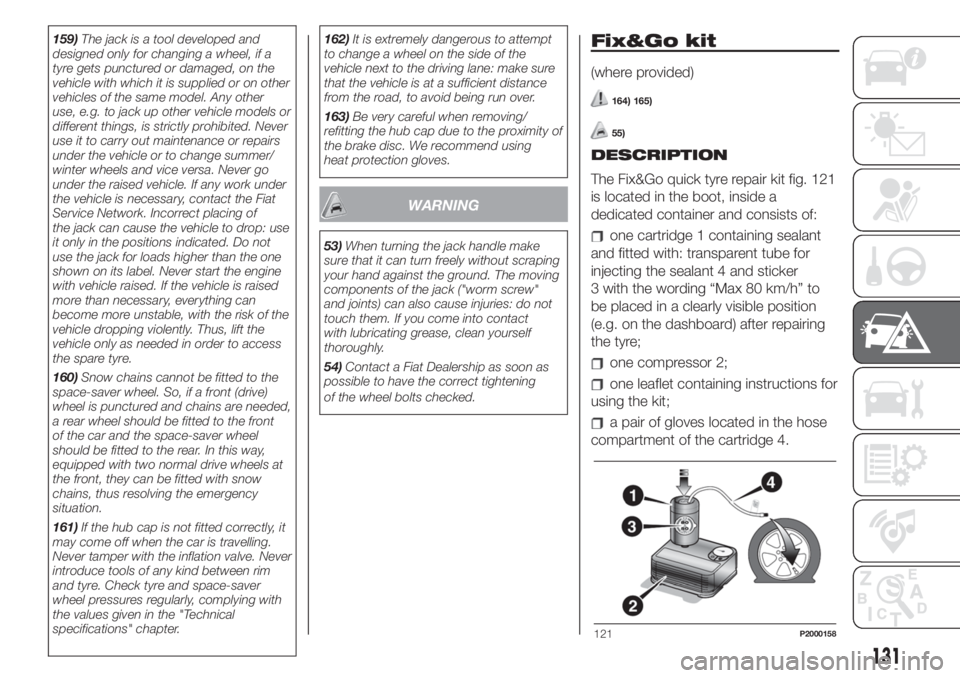
159)The jack is a tool developed and
designed only for changing a wheel, if a
tyre gets punctured or damaged, on the
vehicle with which it is supplied or on other
vehicles of the same model. Any other
use, e.g. to jack up other vehicle models or
different things, is strictly prohibited. Never
use it to carry out maintenance or repairs
under the vehicle or to change summer/
winter wheels and vice versa. Never go
under the raised vehicle. If any work under
the vehicle is necessary, contact the Fiat
Service Network. Incorrect placing of
the jack can cause the vehicle to drop: use
it only in the positions indicated. Do not
use the jack for loads higher than the one
shown on its label. Never start the engine
with vehicle raised. If the vehicle is raised
more than necessary, everything can
become more unstable, with the risk of the
vehicle dropping violently. Thus, lift the
vehicle only as needed in order to access
the spare tyre.
160)Snow chains cannot be fitted to the
space-saver wheel. So, if a front (drive)
wheel is punctured and chains are needed,
a rear wheel should be fitted to the front
of the car and the space-saver wheel
should be fitted to the rear. In this way,
equipped with two normal drive wheels at
the front, they can be fitted with snow
chains, thus resolving the emergency
situation.
161)If the hub cap is not fitted correctly, it
may come off when the car is travelling.
Never tamper with the inflation valve. Never
introduce tools of any kind between rim
and tyre. Check tyre and space-saver
wheel pressures regularly, complying with
the values given in the "Technical
specifications" chapter.162)It is extremely dangerous to attempt
to change a wheel on the side of the
vehicle next to the driving lane: make sure
that the vehicle is at a sufficient distance
from the road, to avoid being run over.
163)Be very careful when removing/
refitting the hub cap due to the proximity of
the brake disc. We recommend using
heat protection gloves.
WARNING
53)When turning the jack handle make
sure that it can turn freely without scraping
your hand against the ground. The moving
components of the jack ("worm screw"
and joints) can also cause injuries: do not
touch them. If you come into contact
with lubricating grease, clean yourself
thoroughly.
54)Contact a Fiat Dealership as soon as
possible to have the correct tightening
of the wheel bolts checked.
Fix&Go kit
(where provided)
164) 165)
55)
DESCRIPTION
The Fix&Go quick tyre repair kit fig. 121
is located in the boot, inside a
dedicated container and consists of:
one cartridge 1 containing sealant
and fitted with: transparent tube for
injecting the sealant 4 and sticker
3 with the wording “Max 80 km/h” to
be placed in a clearly visible position
(e.g. on the dashboard) after repairing
the tyre;
one compressor 2;
one leaflet containing instructions for
using the kit;
a pair of gloves located in the hose
compartment of the cartridge 4.
121P2000158
131
Page 161 of 228
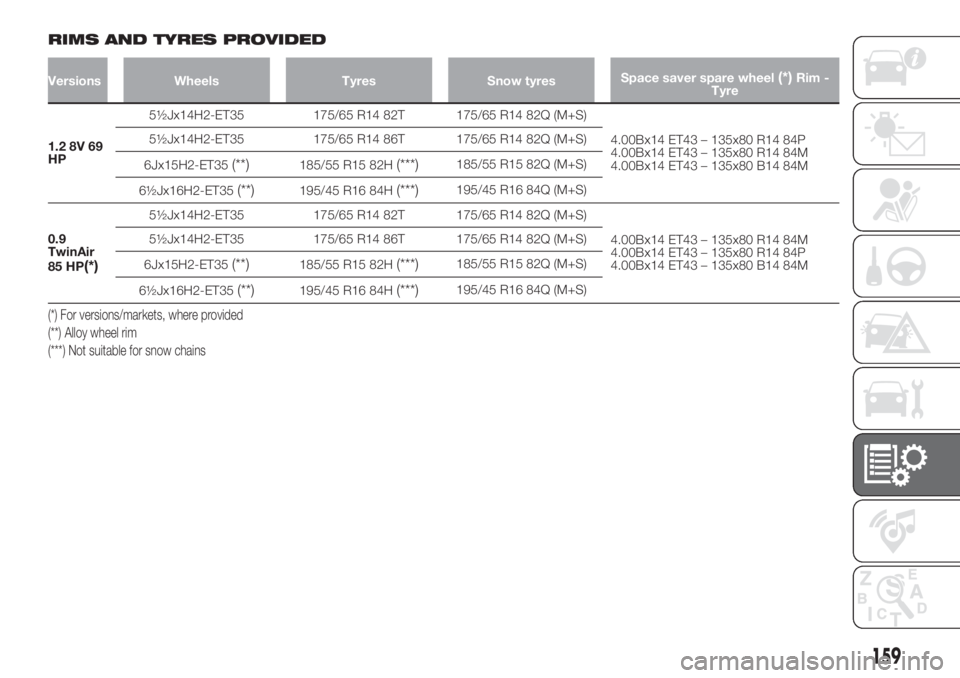
RIMS AND TYRES PROVIDED
Versions Wheels Tyres Snow tyresSpace saver spare wheel(*)Rim -
Tyre
1.2 8V 69
HP5½Jx14H2-ET35 175/65 R14 82T 175/65 R14 82Q (M+S)
4.00Bx14 ET43 – 135x80 R14 84P
4.00Bx14 ET43 – 135x80 R14 84M
4.00Bx14 ET43 – 135x80 B14 84M 5½Jx14H2-ET35 175/65 R14 86T 175/65 R14 82Q (M+S)
6Jx15H2-ET35
(**)185/55 R15 82H(***)185/55 R15 82Q (M+S)
6½Jx16H2-ET35
(**)195/45 R16 84H(***)195/45 R16 84Q (M+S)
0.9
TwinAir
85 HP
(*)
5½Jx14H2-ET35 175/65 R14 82T 175/65 R14 82Q (M+S)
4.00Bx14 ET43 – 135x80 R14 84M
4.00Bx14 ET43 – 135x80 R14 84P
4.00Bx14 ET43 – 135x80 B14 84M 5½Jx14H2-ET35 175/65 R14 86T 175/65 R14 82Q (M+S)
6Jx15H2-ET35
(**)185/55 R15 82H(***)185/55 R15 82Q (M+S)
6½Jx16H2-ET35
(**)195/45 R16 84H(***)195/45 R16 84Q (M+S)
(*) For versions/markets, where provided
(**) Alloy wheel rim
(***) Not suitable for snow chains
159
Page 163 of 228
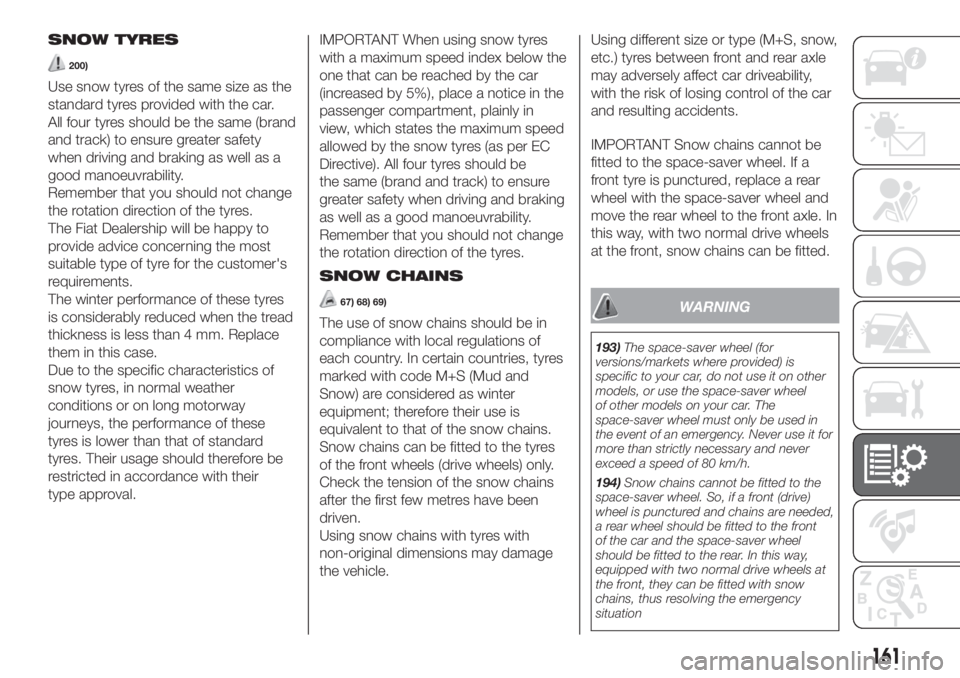
SNOW TYRES
200)
Use snow tyres of the same size as the
standard tyres provided with the car.
All four tyres should be the same (brand
and track) to ensure greater safety
when driving and braking as well as a
good manoeuvrability.
Remember that you should not change
the rotation direction of the tyres.
The Fiat Dealership will be happy to
provide advice concerning the most
suitable type of tyre for the customer's
requirements.
The winter performance of these tyres
is considerably reduced when the tread
thickness is less than 4 mm. Replace
them in this case.
Due to the specific characteristics of
snow tyres, in normal weather
conditions or on long motorway
journeys, the performance of these
tyres is lower than that of standard
tyres. Their usage should therefore be
restricted in accordance with their
type approval.IMPORTANT When using snow tyres
with a maximum speed index below the
one that can be reached by the car
(increased by 5%), place a notice in the
passenger compartment, plainly in
view, which states the maximum speed
allowed by the snow tyres (as per EC
Directive). All four tyres should be
the same (brand and track) to ensure
greater safety when driving and braking
as well as a good manoeuvrability.
Remember that you should not change
the rotation direction of the tyres.
SNOW CHAINS
67) 68) 69)
The use of snow chains should be in
compliance with local regulations of
each country. In certain countries, tyres
marked with code M+S (Mud and
Snow) are considered as winter
equipment; therefore their use is
equivalent to that of the snow chains.
Snow chains can be fitted to the tyres
of the front wheels (drive wheels) only.
Check the tension of the snow chains
after the first few metres have been
driven.
Using snow chains with tyres with
non-original dimensions may damage
the vehicle.Using different size or type (M+S, snow,
etc.) tyres between front and rear axle
may adversely affect car driveability,
with the risk of losing control of the car
and resulting accidents.
IMPORTANT Snow chains cannot be
fitted to the space-saver wheel. If a
front tyre is punctured, replace a rear
wheel with the space-saver wheel and
move the rear wheel to the front axle. In
this way, with two normal drive wheels
at the front, snow chains can be fitted.WARNING
193)The space-saver wheel (for
versions/markets where provided) is
specific to your car, do not use it on other
models, or use the space-saver wheel
of other models on your car. The
space-saver wheel must only be used in
the event of an emergency. Never use it for
more than strictly necessary and never
exceed a speed of 80 km/h.
194)Snow chains cannot be fitted to the
space-saver wheel. So, if a front (drive)
wheel is punctured and chains are needed,
a rear wheel should be fitted to the front
of the car and the space-saver wheel
should be fitted to the rear. In this way,
equipped with two normal drive wheels at
the front, they can be fitted with snow
chains, thus resolving the emergency
situation
161
Page 164 of 228
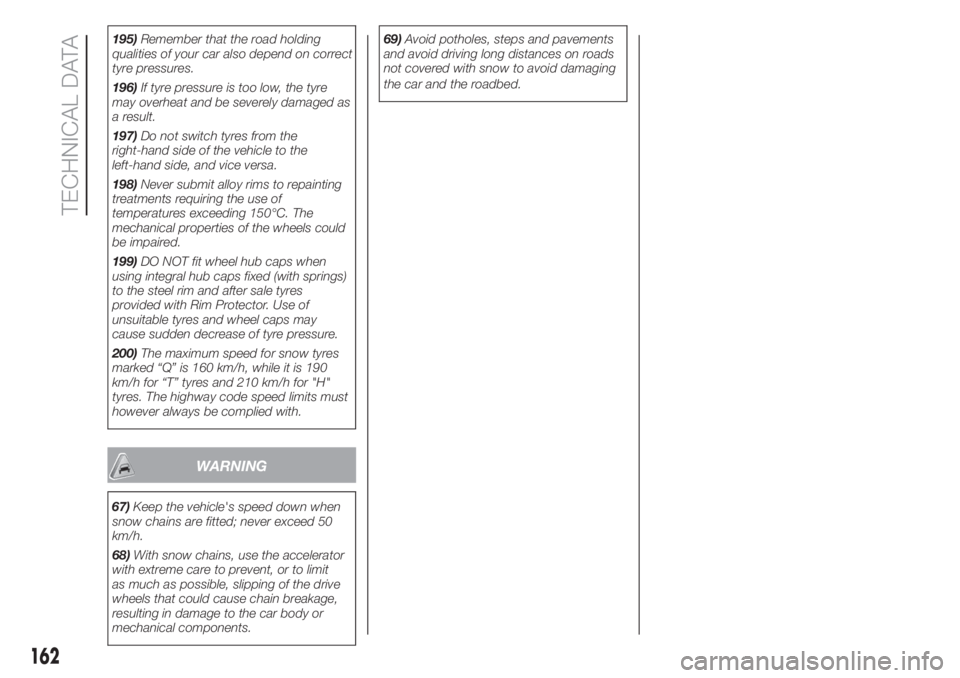
195)Remember that the road holding
qualities of your car also depend on correct
tyre pressures.
196)If tyre pressure is too low, the tyre
may overheat and be severely damaged as
a result.
197)Do not switch tyres from the
righthand side of the vehicle to the
lefthand side, and vice versa.
198)Never submit alloy rims to repainting
treatments requiring the use of
temperatures exceeding 150°C. The
mechanical properties of the wheels could
be impaired.
199)DO NOT fit wheel hub caps when
using integral hub caps fixed (with springs)
to the steel rim and after sale tyres
provided with Rim Protector. Use of
unsuitable tyres and wheel caps may
cause sudden decrease of tyre pressure.
200)The maximum speed for snow tyres
marked “Q” is 160 km/h, while it is 190
km/h for “T” tyres and 210 km/h for "H"
tyres. The highway code speed limits must
however always be complied with.
WARNING
67)Keep the vehicle's speed down when
snow chains are fitted; never exceed 50
km/h.
68)With snow chains, use the accelerator
with extreme care to prevent, or to limit
as much as possible, slipping of the drive
wheels that could cause chain breakage,
resulting in damage to the car body or
mechanical components.69)Avoid potholes, steps and pavements
and avoid driving long distances on roads
not covered with snow to avoid damaging
the car and the roadbed.
162
TECHNICAL DATA
Page 224 of 228
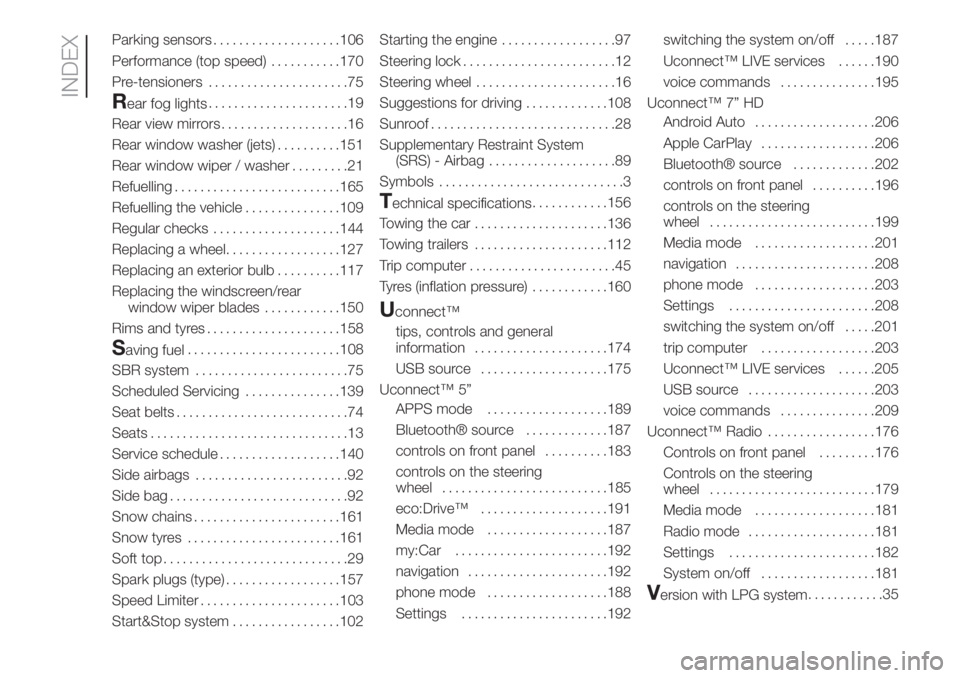
Parking sensors....................106
Performance (top speed)...........170
Pre-tensioners......................75
Rear fog lights......................19
Rear view mirrors....................16
Rear window washer (jets)..........151
Rear window wiper / washer.........21
Refuelling..........................165
Refuelling the vehicle...............109
Regular checks....................144
Replacing a wheel..................127
Replacing an exterior bulb..........117
Replacing the windscreen/rear
window wiper blades............150
Rims and tyres.....................158
Saving fuel........................108
SBR system........................75
Scheduled Servicing...............139
Seat belts...........................74
Seats...............................13
Service schedule...................140
Side airbags........................92
Side bag............................92
Snow chains.......................161
Snow tyres........................161
Soft top.............................29
Spark plugs (type)..................157
Speed Limiter......................103
Start&Stop system.................102Starting the engine..................97
Steering lock........................12
Steering wheel......................16
Suggestions for driving.............108
Sunroof.............................28
Supplementary Restraint System
(SRS) - Airbag....................89
Symbols.............................3
Technical specifications............156
Towing the car.....................136
Towing trailers.....................112
Trip computer.......................45
Tyres (inflation pressure)............160
Uconnect™
tips, controls and general
information.....................174
USB source....................175
Uconnect™ 5”
APPS mode...................189
Bluetooth® source.............187
controls on front panel..........183
controls on the steering
wheel..........................185
eco:Drive™....................191
Media mode...................187
my:Car........................192
navigation......................192
phone mode...................188
Settings.......................192switching the system on/off.....187
Uconnect™ LIVE services......190
voice commands...............195
Uconnect™ 7” HD
Android Auto...................206
Apple CarPlay..................206
Bluetooth® source.............202
controls on front panel..........196
controls on the steering
wheel..........................199
Media mode...................201
navigation......................208
phone mode...................203
Settings.......................208
switching the system on/off.....201
trip computer..................203
Uconnect™ LIVE services......205
USB source....................203
voice commands...............209
Uconnect™ Radio.................176
Controls on front panel.........176
Controls on the steering
wheel
..........................179
Media mode...................181
Radio mode....................181
Settings.......................182
System on/off..................181
Version with LPG system............35
INDEX